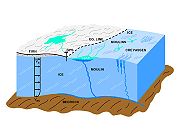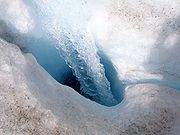
Moulin (geology)
Encyclopedia


Glacier
A glacier is a large persistent body of ice that forms where the accumulation of snow exceeds its ablation over many years, often centuries. At least 0.1 km² in area and 50 m thick, but often much larger, a glacier slowly deforms and flows due to stresses induced by its weight...
through which water enters it from the surface. The term is derived from the French word for mill.
They can be up to 10 meters wide and are typically found at a flat area of a glacier in a region of transverse crevasses. Moulins can go all the way to the bottom of the glacier and can be hundreds of meters deep, or may reach the depth of common crevasse formation (about 10–40 m) where the stream flows englacially. They are the most typical cause for the formation of a glacier cave
Glacier cave
A glacier cave is a cave formed within the ice of a glacier. Glacier caves are often called ice caves, but this term is properly used to describe bedrock caves that contain year-round ice.-Overview:...
.
Moulins are a part of a glacier's internal "plumbing" system, that carry meltwater
Meltwater
Meltwater is the water released by the melting of snow or ice, including glacial ice and ice shelfs over oceans. Meltwater is often found in the ablation zone of glaciers, where the rate of snow cover is reducing...
from the surface down to wherever it may go. Water from moulins often exits the glacier at base level, sometimes into the sea, and occasionally the lower end of a moulin may be exposed in the face of a glacier or at the edge of a stagnant block of ice
Ice
Ice is water frozen into the solid state. Usually ice is the phase known as ice Ih, which is the most abundant of the varying solid phases on the Earth's surface. It can appear transparent or opaque bluish-white color, depending on the presence of impurities or air inclusions...
.
Water from moulins may help lubricate the base of the glacier, affecting glacial motion
Glacial motion
Glacial motion is the motion of glaciers, which can be likened to rivers of ice. It has played an important role in sculpting many landscapes. Most lakes in the world occupy basins scoured out by glaciers...
. Given an appropriate relationship between an ice sheet and the terrain, the head of water in a moulin can provide the power and medium with which a tunnel valley
Tunnel valley
A tunnel valley is a large, long, U-shaped valley originally cut under the glacial ice near the margin of continental ice sheets such as that now covering Antarctica and formerly covering portions of all continents during past glacial ages....
may be formed. The role of water in lubricating the base of ice sheets and glaciers is complex. Difficulties modelling this process led to apparently over-optimistic predictions of sea level rise by the IPCC
Intergovernmental Panel on Climate Change
The Intergovernmental Panel on Climate Change is a scientific intergovernmental body which provides comprehensive assessments of current scientific, technical and socio-economic information worldwide about the risk of climate change caused by human activity, its potential environmental and...
in the IPCC fourth assessment report
IPCC Fourth Assessment Report
Climate Change 2007, the Fourth Assessment Report of the United Nations Intergovernmental Panel on Climate Change , is the fourth in a series of reports intended to assess scientific, technical and socio-economic information concerning climate change, its potential effects, and options for...
. Recent research by Stefan Rahmstorf
Stefan Rahmstorf
Stefan Rahmstorf is a German oceanographer and climatologist. Since 2000, he has been a Professor of Physics of the Oceans at Potsdam University. He received his Ph.D. in oceanography from Victoria University of Wellington...
, released at the Climate Congress suggests that sea level rise will be greater than predicted in the IPCC's report.
See also
- FirnFirnFirn is partially-compacted névé, a type of snow that has been left over from past seasons and has been recrystallized into a substance denser than névé. It is ice that is at an intermediate stage between snow and glacial ice...
- Giant's kettle
- Holocene glacial retreatHolocene glacial retreatHolocene glacial retreat had a profound effect on landscapes in many areas that were covered by ice at the Last Glacial Maximum. The many valleys of the Cairngorms, a mountainous region in the Eastern Scottish Highlands are littered with deposits from this period.-Evidences of the retreat of the...
- Melt pond
- SinkholeSinkholeA sinkhole, also known as a sink, shake hole, swallow hole, swallet, doline or cenote, is a natural depression or hole in the Earth's surface caused by karst processes — the chemical dissolution of carbonate rocks or suffosion processes for example in sandstone...
- Snake coilsSnake coils (geology)Snake coils is a descriptive term used by physical geologist and glaciologists to describe the "snake coil"-like shape that occurs along certain ablation lines. Essentially miniature tunnel valleys, the peculiar natural shapes were first described by French Geologist Jean-Jerome Peytavi in 1973...
- Subglacial lakeSubglacial lakeA subglacial lake is a lake under a glacier, typically an ice cap or ice sheet. There are many such lakes, with Lake Vostok in Antarctica being by far the largest known at present.-Characteristics:...
- Supraglacial lakeSupraglacial lakeA supraglacial lake is any pond of liquid water on the top of a glacier. Although these pools are , they may reach kilometers in diameter and be several meters deep...
External links
- Earth Observatory page.
- http://www.jpl.nasa.gov/news/features.cfm?feature=1243December 2006 article about a NASANASAThe National Aeronautics and Space Administration is the agency of the United States government that is responsible for the nation's civilian space program and for aeronautics and aerospace research...
expedition to Greenland moulin.] - Moulins in Greenland (Google)

